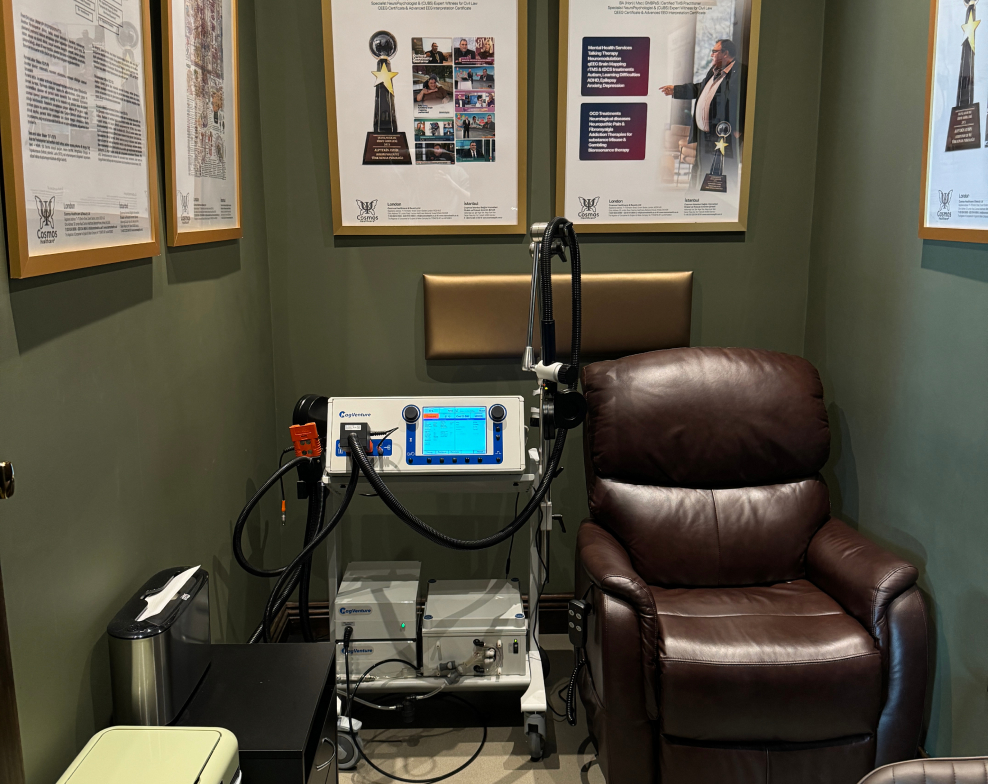

qEEG Guided, Personalized rTMS Primary Progressive Aphasia Treatment
Understanding Primary Progressive Aphasia (PPA): The Neurological Disorder That Impacts Language and Cognition and its Treatment via qEEG-Guided rTMS with the Neuromap Algorithm
Primary Progressive Aphasia (PPA) represents a complex neurodegenerative condition which is uncommon and affects how people process language and communicate. PPA stands apart from other aphasia types due to its progressive erosion of speech production and comprehension abilities as well as reading and writing skills because of brain atrophy in the frontal and temporal lobes.
Treatment plans for PPA need to concentrate on improving neuroplasticity while strengthening neural pathways and regulating brain activity to extend the preservation of language abilities because of its progressive progression. Repetitive Transcranial Magnetic Stimulation (rTMS) stands out as a promising treatment for PPA because it integrates qEEG functional brain mapping with the Neuromap AI algorithm. The advanced treatment modality enables precise therapy by targeting the affected brain areas specific to each patient individually.
The application of qEEG-Guided rTMS provides therapeutic benefits for PPA patients by aiding in the restoration of language capabilities.
Repetitive Transcranial Magnetic Stimulation (rTMS) constitutes a non-invasive neuromodulation method which employs electromagnetic pulses to control neural activity within the brain. rTMS application to distinct language-related areas of the cortex results in improved speech fluency and better sentence construction and word retrieval.
The joint use of qEEG functional brain mapping together with Neuromap AI algorithm transforms PPA therapy by creating individual brain activity maps that pinpoint optimal stimulation areas for each patient.
Quantitative Electroencephalography (qEEG) plays an essential role by mapping language dysfunction in Primary Progressive Aphasia (PPA).
Quantitative Electroencephalography (qEEG) enables precise analysis of brain activity as it happens while identifying important biomarkers for PPA.
– The left inferior frontal gyrus, known as Broca’s area shows reduced beta and gamma activity which results in challenges with speech production and articulation.
– The connection between the temporal and parietal lobes has diminished which impacts word retrieval abilities as well as sentence construction and language comprehension.
– Wernicke’s area shows disrupted alpha and theta wave patterns which leads to challenges in comprehending both written and verbal language.
– The left hemisphere shows asymmetrical activity which plays an essential role in language processing.
The Neuromap AI algorithm analyzes abnormalities in qEEG data to produce an individualized treatment plan that directs rTMS therapy with unmatched precision.
The use of rTMS to adjust language networks in PPA focuses specifically on key brain regions.
Correct cortical areas responsible for speech production, word retrieval and comprehension must be stimulated for rTMS to successfully treat PPA. The qEEG-guided Neuromap algorithm identifies brain regions and modifies stimulation settings in real-time according to how the patient reacts.
Broca’s Area in the Left Inferior Frontal Gyrus plays a critical role in speech production and articulation.
– Speech fluency and sentence structure in patients with PPA showed improvement following rTMS stimulation at Broca’s area.
– High-frequency rTMS at 10 Hz targeting Broca’s area results in positive changes to verbal expression skills.
– Non-fluent PPA patients undergoing rTMS treatment at Broca’s area displayed enhanced articulation abilities and experienced fewer conversational pauses.
The angular and supramarginal gyri of the parietal lobe facilitate word retrieval and sentence formation.
– Because of its vital role in phonological and semantic processing the parietal lobe stands out as an essential focus for rTMS therapy.
– Logopenic PPA patients show disrupted neural activity in the left inferior parietal cortex according to qEEG scans which results in challenges with word retrieval and sentence formation.
– The use of rTMS on the left parietal lobe improves patients’ ability to find words which enables them to communicate with greater effectiveness.
Wernicke’s Area (Superior Temporal Gyrus) – Language Comprehension
– Semantic variant PPA patients lose their ability to comprehend words and concepts.
– qEEG data frequently display abnormal slow-wave activity in Wernicke’s area which corresponds with language comprehension problems both in spoken and written forms.
– The application of rTMS to Wernicke’s area results in better auditory and reading comprehension which enables patients to process words with greater efficiency.
The Dorsolateral Prefrontal Cortex (DLPFC) plays a role in both cognitive flexibility and memory processes in PPA.
– PPA patients display executive function deficits which hinder their ability to transition between thoughts while planning responses and maintaining coherent speech.
– The application of rTMS to the left DLPFC leads to improved cognitive flexibility and enables PPA patients to sustain conversations and reduce speaking frustration.
– Applying rTMS to the DLPFC produces better working memory results as well as improved verbal recall and sentence structuring capabilities among logopenic PPA patients.

Scientific Evidence Supporting rTMS for PPA
New research demonstrates rTMS’s capacity to decelerate language decline while enhancing communicative skills in patients suffering from PPA.
– A sham-controlled research study published in Brain Stimulation demonstrated that rTMS treatment targeting Broca’s area produced significant enhancements in speech fluency and naming abilities among non-fluent Primary Progressive Aphasia patients.
– A clinical trial reported in Frontiers in Human Neuroscience showed that rTMS therapy targeting the parietal cortex led to better word retrieval for logopenic PPA patients and decreased word-finding pauses during everyday conversations.
– The Journal of Neurolinguistics published a meta-analysis which found that rTMS produces lasting neuroplastic changes resulting in ongoing language function improvements beyond treatment completion.
The results indicate that qEEG-guided rTMS remains among the top treatment options for maintaining language function in individuals with PPA.
Research demonstrates that qEEG-guided rTMS produces enduring neuroplasticity improvements leading to sustained language function recovery in PPA patients post-treatment.
The treatment strategy of rTMS in progressive PPA aims to achieve not only temporary symptom relief but also enduring stabilization of language processing neural networks.
– Through neuroplastic changes induced by rTMS treatment the brain develops compensatory mechanisms which enable alternative neural pathways to assume lost functions from neurodegeneration.
– Scheduled rTMS sessions that use qEEG monitoring protect cognitive abilities while slowing speech and language deterioration.
– The administration of qEEG-personalized rTMS therapy enables patients to better manage everyday communication challenges which leads to enhanced quality of life and improved social engagement.
The upcoming era of PPA treatment will center around personalized therapeutic strategies that integrate qEEG analysis with Neuromap technologies.
Advances in neurotechnology are making qEEG-guided neuromodulation a vital method for diagnosing and treating neurodegenerative language conditions such as PPA. Real-time qEEG functional insights together with AI Neuromap analytics and precision rTMS therapy create a groundbreaking approach to patient-centered care.
The integration of advanced neuroscience techniques with artificial intelligence creates a promising treatment option for PPA patients which scientifically proves to significantly enhance speech and language functions beyond current limits.
The upcoming years will see qEEG-guided rTMS establish itself as an essential method in customizing PPA treatments by connecting precise diagnostics with successful treatment approaches.